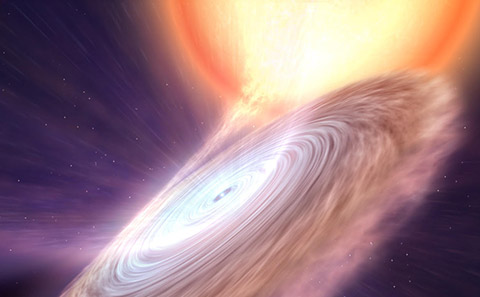
Using the most powerful telescopes on Earth and in space, a team of astronomers has found for the first-time blasts of hot, warm and cold winds from a neutron star whilst it consumes matter from a nearby star. The discovery provides new insight into the behaviours of some of the most extreme objects in the universe.
Low-mass X-ray binaries (LMXBs) are systems containing a neutron star or black hole. They are fuelled by material ripped from a neighbouring star, a process known as accretion. Most accretion occurs during violent eruptions where the systems brighten dramatically. At the same time, some of the material that spirals in is propelled back into space in the form of disc winds and jets.
The most common signs of outflowing material from astronomical objects are associated with "warm" gas. Despite this, only winds of "hot" or "cold" gas have been observed in transient X-ray binaries, until now.
In this new study, a team of researchers from eleven countries, led by the University of Southampton, studied the recent eruption of the X-ray binary known as Swift J1858. They used a combination of telescopes, including NASA's Hubble Space Telescope (HST), the European Space Agency's XMM-Newton satellite, the European Southern Observatory Organisation's Very Large Telescope (VLT) and the Spanish Gran Telescopio Canarias (GTC).
The results, published in the journal Nature, showed persistent signatures of a warm wind at ultraviolet wavelengths occurring at the same time as signatures of a cold wind at optical wavelengths. This is the first time that winds from such a system have been seen across different bands of the electromagnetic spectrum.
Lead author Dr Noel Castro Segura, of the University of Southampton said: "Eruptions like this are rare, and each of them is unique. Normally they are heavily obscured by interstellar dust, which makes observing them really difficult. Swift J1858 was special, because even though it is located on the other side of our galaxy, the obscuration was small enough to allow for a full multiwavelength study."
"Only one other system — the black hole X-ray binary, V404 Cyg — has shown similar properties. However, our attempt to perform the same experiment on that system was unsuccessful, because the eruption ended before we could get the ground-based and space-based telescopes to observe it simultaneously," co-Author Dr Hernández Santisteban from University of St Andrews said.
Swift J1858 is a newly discovered X-ray transient event that displays extreme variability across the electromagnetic spectrum, which presented a rare opportunity.
"All the astronomers in the field were incredibly excited, to the point that we combined our efforts to cover the full spectrum, from radio to X-ray using state-of-art observatories on Earth and in space," Dr Castro Segura continued.
Co-author Nathalie Degenaar, from the University of Amsterdam added, "Neutron stars have an immensely strong gravitational pull that allows them to gobble up gas from other stars. The stellar cannibals are, however, messy eaters and much of the gas that neutron stars pull towards them is not consumed, but flung into space at high speed. This behaviour has a large impact both on the neutron star itself, and on its immediate surroundings. In this paper we report on a new discovery that provides key information about the messy eating patterns of these cosmic cookie monsters."






